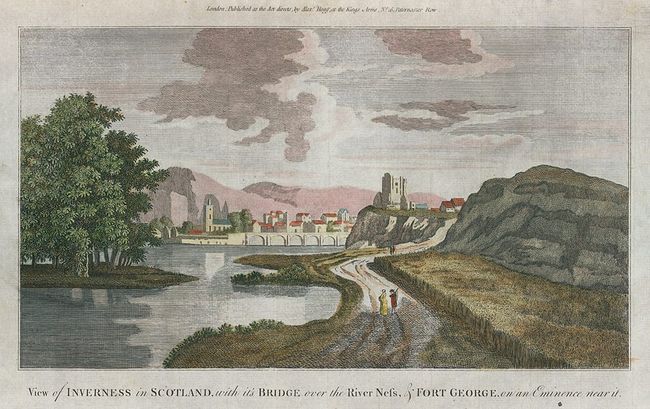Annotation:Adieu to Fortgeorge: Difference between revisions
(Created page with "'''Back to [[{{BASEPAGENAME}}]]''' ---- <p><font face="garamond, serif" size="4"> '''ADIEU TO FORTGEORGE'''. Scottish, March (cut time). D Major. Standard tuning (fiddle). AAB...") |
m (Text replacement - "garamond, serif" to "sans-serif") |
||
| (4 intermediate revisions by one other user not shown) | |||
| Line 1: | Line 1: | ||
'''Back to [[{{BASEPAGENAME}}]]''' | =='''Back to [[{{BASEPAGENAME}}]]'''== | ||
---- | ---- | ||
<p><font face=" | <p><font face="sans-serif" size="4"> | ||
'''ADIEU TO FORTGEORGE'''. Scottish, March (cut time). D Major. Standard tuning (fiddle). AABBCCDD. | '''ADIEU TO FORTGEORGE'''. Scottish, March (cut time). D Major. Standard tuning (fiddle). AABBCCDD. There were two Fort Georges in Scotland, both named for Hanoverian monarchs. The first was near Inverness in the Scottish Highlands, built after the 1715 Jacobite uprising to help pacify the surrounding countryside. The second Fort George was a large mid-18th century fortress near Ardersier, to the north-east of Inverness, and, like its predecessor, it was built in the aftermath of the Jacobite rising of 1745. Fort George [https://en.wikipedia.org/wiki/Fort_George,_Highland] has been in continuous use as a garrison. | ||
[[File:fortgeorge.jpg|650px|thumb|left|Inverness 1784, with Fort George on the height in the mid-ground.]] | |||
<br> | <br> | ||
<br> | <br> | ||
</font></p> | </font></p> | ||
<p><font face=" | <p><font face="sans-serif" size="4"> | ||
''Source for notated version'': | ''Source for notated version'': | ||
<br> | <br> | ||
<br> | <br> | ||
</font></p> | </font></p> | ||
<p><font face=" | <p><font face="sans-serif" size="4"> | ||
''Printed sources'': Anderson ('''Anderson's Budget of Strathspeys, Reels & Country Dances for the German Flute or Violin'''), Edinburgh, 1820; p. 10. | ''Printed sources'': Anderson ('''Anderson's Budget of Strathspeys, Reels & Country Dances for the German Flute or Violin'''), Edinburgh, 1820; p. 10. | ||
<br> | <br> | ||
<br> | <br> | ||
</font></p> | </font></p> | ||
<p><font face=" | <p><font face="sans-serif" size="4"> | ||
''Recorded sources'': <font color=teal></font> | ''Recorded sources'': <font color=teal></font> | ||
</font></p> | </font></p> | ||
| Line 22: | Line 23: | ||
<br> | <br> | ||
---- | ---- | ||
'''Back to [[{{BASEPAGENAME}}]]''' | =='''Back to [[{{BASEPAGENAME}}]]'''== | ||
Latest revision as of 10:59, 6 May 2019
Back to Adieu to Fortgeorge
ADIEU TO FORTGEORGE. Scottish, March (cut time). D Major. Standard tuning (fiddle). AABBCCDD. There were two Fort Georges in Scotland, both named for Hanoverian monarchs. The first was near Inverness in the Scottish Highlands, built after the 1715 Jacobite uprising to help pacify the surrounding countryside. The second Fort George was a large mid-18th century fortress near Ardersier, to the north-east of Inverness, and, like its predecessor, it was built in the aftermath of the Jacobite rising of 1745. Fort George [1] has been in continuous use as a garrison.

Source for notated version:
Printed sources: Anderson (Anderson's Budget of Strathspeys, Reels & Country Dances for the German Flute or Violin), Edinburgh, 1820; p. 10.
Recorded sources:
